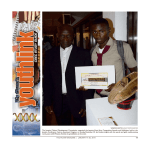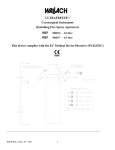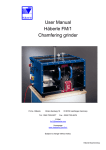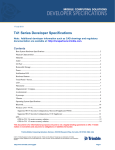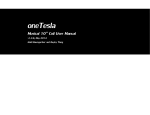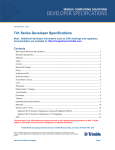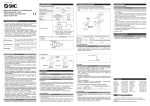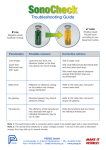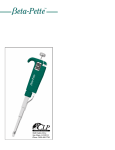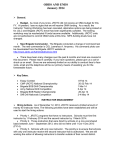Download WRc Assessment of QuickLock
Transcript
UHRIG KANALTECHNIK ASSESSMENT OF THE UHRIG KANALTECHNIK QUICK LOCK LOCAL REPAIR SYSTEM WRc Ref: UC7982 June 2009 ASSESSMENT OF THE UHRIG KANALTECHNIK QUICK LOCK LOCAL REPAIR SYSTEM Report: UC7982 Date: June 2009 Authors: K Adams and A T Russell Contract Manager: A T Russell Contract No.: 15042-0 RESTRICTION: This report has the following limited distribution: External: Client Internal: Authors Any enquiries relating to this report should be referred to the authors at the following address: WRc Swindon, Frankland Road, Blagrove, Swindon, Wiltshire, SN5 8YF. Telephone: + 44 (0) 1793 865000 Fax: + 44 (0) 1793 865001 Website: www.wrcplc.co.uk The contents of this document are subject to copyright and all rights are reserved. No part of this document may be reproduced, stored in a retrieval system or transmitted, in any form or by any means electronic, mechanical, photocopying, recording or otherwise, without the prior written consent of the copyright owner. This document has been produced by WRc plc. CONTENTS 1. INTRODUCTION 1 1.1 1.2 Outline of system The WRc Approved™ Scheme 1 1 2. SUPPLIED THIRD PARTY AUDIT AND TESTING REPORTS 3 3. MATERIAL PROPERTIES 5 3.1 3.2 3.3 Introduction EPDM Rubber gasket Steel Sleeve 5 5 5 4. STRUCTURAL DESIGN 7 4.1 Structural design of the Quick Lock System 7 5. FACTORY AUDIT 9 5.1 5.2 5.3 5.4 5.5 Background Quality Assurance system Rubber Gasket production Steel Sleeve production UHRIG Kanaltechnik checking of finished components 9 9 9 11 12 6. LONG TERM HYDROSTATIC TESTING 15 7. JETTING RESISTANCE TESTING 17 8. INSTALLATION MANUAL 19 9. SITE INSTALLATION AUDITS 21 9.1 9.2 9.3 Scope of audit Audit criteria Site audit Albbruck 21 21 22 10. CONCLUSIONS 25 APPENDICES APPENDIX A APPENDIX B APPENDIX C QUICK LOCK ASSESSMENT SCHEDULE QUICK LOCK LONG TERM HYDROSTATIC PERFORMANCE TEST QUICK LOCK LONG HIGH PRESSURE WATER JETTING PERFORMANCE TEST LIST OF FIGURES Figure 5.1 Figure 5.2 Work station with table of tolerance requirement and examples of gaskets defects Finished goods storage at UHRIG Kanaltechnik 12 13 LIST OF TABLES Table 2.1 Table 3.1 Daily hydrostatic pressure profile during ‘wet’ testing Installation summary 4 11 1. INTRODUCTION 1.1 Outline of system The “Quick Lock” is a local repair system supplied by Uhrig Kanaltechnik GmbH of Geisingen Germany. The system consists of two components that are assembled on site prior to installation. An EPDM rubber gasket is pulled over a coiled steel sleeve which contains a unidirectional locking mechanism to form the Quick Lock Repair. The Quick Lock repair is positioned in the pipe over the defect by using CCTV and an inflatable packer. Once in position the packer is inflated thereby uncoiling the steel sleeve and engaging the locking mechanism. The expansion of the steel sleeve compresses the rubber gasket between the walls of the steel sleeve and host pipe. When the packer is deflated, the repair remains in position as the locking mechanism is uni-directional. The Quick Lock can be installed either as a single stand alone repair or in series when the Quick Lock repairs are overlapped to form a continuous repair. The Quick Lock repair is available in a range of diameters: • Diameter 150 mm-700 m in length of 400 mm lengths • Diameter 500 mm-800 m in length of 500 mm lengths The Quick Lock is Approval is at present for use in foul and surface water drainage. 1.2 The WRc Approved™ Scheme WRc Approved™ assesses the performance of a product as it relates to the application defined by the manufacturer or supplier. The evaluation of the product is based upon an Assessment Schedule that is prepared by WRc in conjunction with the manufacturer or supplier of the product. Once a product has been approved and the certificate is issued, the Assessment Schedule becomes a publicly available document. The requirements of an Assessment Schedule typically include: • the description of the product/service and scope of the approval; • the tests used to assess the performance of the product/service; • an evaluation of the installation instructions including witnessing the use of the product onsite at two locations, and; • an audit of the quality control procedures used in the manufacture/operation of the system. The Assessment Schedule for the Quick Lock System is included in Appendix A of this report. WRc Ref: UC7982 June 2009 1 WRc Ref: UC7982 June 2009 2 2. SUPPLIED THIRD PARTY AUDIT AND TESTING REPORTS UHRIG Kanaltechnik GmbH supplied translated copies of third party audits and testing undertaken of the Quick Lock system as a whole and its components. The documents supplied were: • Deutches Insititut fur Bautechnik (DIBT): General Approval by the building authority’s approval number Z-42.3.374 (Issue April 2005 valid until April 2010). • Fachhochschule Münster University of Applied Sciences; External pressure test on Quick Lock Sleeves DN200 to DN600. (31 October 2008). • IRO Oldenburg GmbH: Jetting resistance test according to draft DIN Standard 19523 August 2007. • MPA Darmstadt Staatliche Materalprufungsanstalt Darmstadt- records of previous audits undertaken by Winfred Lobig of Technische Universaitate Darmstadt. WRc Ref: UC7982 June 2009 3 WRc Ref: UC7982 June 2009 4 3. MATERIAL PROPERTIES 3.1 Introduction The installed system consists of two the EPDM Rubber gasket and Steel Sleeve. As the system is installation by mechanical bracing there are no additional chemicals products (e.g. resins, glues). 3.2 EPDM Rubber gasket The rubber gaskets are manufactures for materials that compile the German DIN Standards listed below: • DIN 53504: Tensile strength, Elongation, modulus. • DIN 53505: Hardness. • DIN 53519: Compression. • DIN ISO 1183: Specific gravity. • DIN ISO 815: Compression set, stress relaxation. DIN 53529 Rheometer Monsanto 200 3.3 Steel Sleeve The Quick Lock system utilises V4A stainless steel which is suitable for use in wastewater applications. There are no structural requirements for the steel sleeve, refer to Section 4.1. WRc Ref: UC7982 June 2009 5 WRc Ref: UC7982 June 2009 6 4. STRUCTURAL DESIGN 4.1 Structural design of the Quick Lock System Research undertaken by WRc in collaboration with a number of UK Water and Sewerage Companies and manufacturers and suppliers of sewer repair systems has been undertaken in our Underground Testing Facility. Loading trials have demonstrated that patch (local) repairs do not have to be structurally designed. They do though have to be leaktight to ensure that infiltration of groundwater will not occur as infiltrating water could potentially erode the ground supporting the sewer and hence lead to collapse. A suite of collaborative research projects have been undertaken which have resulted in a long term (i.e. 6 month duration) hydrostatic test procedure which demonstrates the leak tightness potential of sewer repairs to simulated variations in groundwater level. This procedure is included within the following documents: • WIS 4-34-06 “Specification for localised sewer repairs using cured-in-place systems with or without re-rounding”, November 2008: Issue 1. • Drain repair manual, 2nd Edition, WRc, 2005. The Quick Lock system is currently undergoing WRc long term hydrostatic testing and the results of this testing will be available during May 2009. WRc Ref: UC7982 June 2009 7 WRc Ref: UC7982 June 2009 8 5. FACTORY AUDIT 5.1 Background Kevin Adams of WRc audited the manufacturing process of the Quick Lock system on 27th and 28th January 2009. The production of the Quick Lock is undertaken in three stages by three separate local companies under the control of Uhrig Kanaltechnik GmbH. The Uhrig Kanaltechnik GmbH premises are primarily used for the storage of finished goods. For the factory audit, four premises were visited for different stages of the manufacture and assembly of the Quick Lock repair • Südbadische Gummiwerke GmbH : Manufacture of EPDM rubber gasket. • Gerstmaier Blechverabeitung GmbH: Cutting of tooth slot and preparation of steel sleeve uncoiled. • Graf Feinmechanik GmbH: Fitting of locking mechanism and coiling of steel sleeve. • Uhrig Kanaltechnik GmbH : Storage of finished components. 5.2 Quality Assurance system Uhrig Kanaltechnik GmbH operate an in-house Quality Assurance systems that monitors the production procedure for the receipt of raw components to the finished lining ready for despatch, inclusive of when the components are transferred between companies. Uhrig Kanaltechnik GmbH does not hold ISO9001 certification. The factory audit was undertaken concurrently with a quality audit undertaken by Technische Universaitate Darmstadt. This external audit is undertaken twice every year and covers the manufacturing process of Quick Lock Repair components. The audit for Staatliche Materialprüfungsanstalt Darmstadt was undertaken by Winfred Löbig. 5.3 Rubber Gasket production 5.3.1 Specification requirement of rubber The rubber gaskets are manufactured by Südbadische Gummiwerke GmbH to Uhrig Kanaltechnik material and dimensional specifications. The technical data sheet of the required material properties of the raw rubber material for the manufacture of the gaskets was presented to WRc. This listed required vulcanised condition of the rubber against current German standards, these include: • DIN 53504: Tensile strength, Elongation, modulus. • DIN 53505: Hardness. WRc Ref: UC7982 June 2009 9 • DIN 53519: Compression. • DIN ISO 1183: Specific gravity. • DIN ISO 815: Compression set, stress relaxation. • DIN 53529 Rheometer Monsanto 200 E. 5.3.2 Quality checks on receipt of rubber Kraiburg GmbH & Co KG, Waldkraiburg are the suppliers to Südbadische Gummiwerke GmbH of the rubber that is delivered in sheet format. Each batch delivery is accompanied by a certificate of compliance from Kraiburg GmbH & Co KG as a requirement of the supplier agreement. The certificate lists the tolerance of each parameter and the declared value of the batch. The batch is held in storage in a pending area until the declared material properties of the batch are confirmed by in house testing. In house property checks include: hardness, density and elasticity. Südbadische Gummiwerke GmbH provided historic records of the past in-house testing of received goods. Deliveries passing the in-house checks are then brought into the stock; any deliveries failing are rejected. 5.3.3 Production of gasket The rubber sheets are cut into pieces and allocated by weight for each sleeve. The weight required for the sleeve is dependent upon the diameters of the finished gasket. The shape and size of the rubber pieces is not important to the manufacturing process other than all pieces fitting in the gasket mould. The key factor is the total weight of the rubber pieces. It was noted that the parameters of the weight of rubber for each of the gasket diameter sizes was available to the machine operators. The mould process is automated with the time and temperature set. When the gasket has been produced it is removed from the mould and visually inspected of defects. The gasket is allowed to cool and then manual stamped with a birth tag, for point and date of manufacture. Südbadische Gummiwerke GmbH undertaken final in house quality checks a sample of gasket’s properties for hardness, tensile strength, elongation and compression; physical dimensions are also checked. Any gasket’s failing to meet the specification will be rejected and further testing is undertaken on the appropriate production batch. The gaskets are then transferred to Uhrig Kanaltechnik’s storage facilities. WRc Ref: UC7982 June 2009 10 5.4 Steel Sleeve production 5.4.1 Purchase of steel Uhrig Kanaltechnik GmbH Purchase the V4A steel sheets cut to shape from Outo Kumpu (Finland). Visual inspection and dimensional checks are undertaken on the sheets before they are transferred to Gerstmaier Blechverabeitung GmbH for the cutting of the toothed slot. Uhrig Kanaltechnik GmbH has a customer agreement and quality specification for the steel with Outo Kumpu. 5.4.2 Cutting of toothed slots The steel sheets are received by Gerstmaier Blechverabeitung GmbH from Uhrig Kanaltechnik GmbH storage and visually inspected prior to cutting. The cutting process is fully automated and parameters are dependent upon the diameter of the Quick Lock repair. Once the toothed slot has been cut, the sheet is cleared of burs and shavings and visually inspected. A physical check on the cut slot is undertaken on the first, last and intermediate (typically every 75) sheets from any batch to ensure the locking mechanism will fit and function. Gerstmaier Blechverabeitung GmbH have a “free standing” version of the 3 cog locking mechanism which is used to physically ensure the toothed slots are cut within tolerance and the lock will function as designed. As the locking mechanism used is free standing, it can simply be disassembled and removed from the slot and reused in subsequent quality checks. It was noted that the factory was tidy, goods clearly labelled and records of production maintained 5.4.3 Fitting locks and coiling of cut steel sheets The coiling of the sheets, manufacture and the fitting of the locks is undertaken by Graf Feinmechanik GmbH at their workshop. The technique of coiling the cut steel sheet is a guarded process. The process is semiautomated so that the coiled sleeve is less than the diameter of the intended pipe. The cogs for the locking mechanism are manufactured by Graf Feinmechanik GmbH on site by an automated cutting process from solid per cut cores of steel. The fitting of the lock is a precise, intricate manual process. The cut slot is checked with a free standing locking mechanism prior to the lock being fitted. The coiled sleeves with fitted locks are then transferred to Uhrig Kanaltechnik for finished component storage. It was noted for each of the machines used for the process, a method statement and the product allowable parameters were readily available. The workshop was clean and tidy. WRc Ref: UC7982 June 2009 11 5.5 Uhrig Kanaltechnik GmbH checking of finished components 5.5.1 Rubber gasket The gaskets undergo testing for dimensional properties before becoming finished goods ready for despatch to the installer. The gasket is visually inspected; dimensions of the gaskets are checked to ensure that they are within the tolerance of the specification. Measurements taken are: • Wall thickness. • Total length. • Height of circumferential sealing ribs/knobs. • Distance between the end of the gasket and circumferential sealing ribs/knobs. • Distance between the circumferential sealing ribs/knobs. It was noted that a schematic with the tolerance was on display at the work station in the finished good store. The work station also contained a display of cut outs for rejected seals as an aid to what is not acceptable. Staatliche Materialprüfungsanstalt Darmstadt conducted a visual inspection and dimensions check on a randomly select gasket from storage. The gasket had no visible defects and all measurements were found to be within tolerance of the specification for the diameter. Figure 5.1 Work station with table of tolerance requirement and examples of gaskets defects WRc Ref: UC7982 June 2009 12 5.5.2 Steel sleeve The sleeves entering Uhrig Kanaltechnik final goods store are subject to a visual inspection and dimensional check. It is not possible to test the performance of the locking mechanism with out sacrificing the sleeve since it is not possible to reverse the expanding action of the lock. Staatliche Materialprüfungsanstalt Darmstadt conducted a visual inspection and dimensions check on a randomly select sleeve from storage. A 150 mm diameter steel sleeve was fully expanded to check that the tolerances of the expanded sleeve were met. A 150 mm sleeve is chosen as the sleeve is not usable once the lock has been fully open. The steel sleeve had no visible defects and all measurements were found to be within tolerance of the specification for the diameter. The locking mechanism performed within the specified tolerances. 5.5.3 Storage of finished components WRc inspected the storage facilities and the following observations were made: • The storage area was tidy, laid out in an orderly manner with allotted storage space for each component, based on diameter of the gasket or steel sleeve, to enable items to be easily located. • All goods were clearly labelled. Figure 5.2 Finished goods storage at Uhrig Kanaltechnik GmbH WRc Ref: UC7982 June 2009 13 WRc Ref: UC7982 June 2009 14 6. LONG TERM HYDROSTATIC TESTING The objective of this project was to conduct the long-term external hydrostatic pressure test on the Quick Lock localised repair system and determine whether the installed repair can achieve an acceptable level of leak tightness. All three Uhrig Quick Lock patch repairs passed the long-term external hydrostatic water pressure (leaktightness) test carried out in accordance with the revised Appendix B of the Specification for Local Sewer Repairs, Issue 2, 2005. For all three installed repairs in was noted that there was evidence of infiltration approximately 2 hours after the pressure cycle had reached 5m head. However it was common occurrence for the infiltration not to be sufficient to reach the each of the pipe before the applied pressure was reduced from 5 m. There the measured infiltration is seen as minimal and only when 5 m of external pressure applied. Detail report has been included in Appendix B. WRc Ref: UC7982 June 2009 15 WRc Ref: UC7982 June 2009 16 7. JETTING RESISTANCE TESTING The system has demonstrated that it passes the WIS requirement when high pressure jetting is in accordance with your installation manual. When reviewing the results of the testing the following points have been taken into consideration: • The system passes when high pressure is applied to the tapered end of the repair (as the jetting head is pulled back). The installation manual clearly states this. • Although jetting water passed the non-tapered end seal it was difficult to position our jetting nozzle and we consider it very unlikely in practice for a jetting nozzle to get into such a position and apply a force under the steel lip. • Please confirm that when the repairs are installed in series a non-tapered end and tapered end abut. Is it possible that both ends of the assembly have a tapered end? • Also, would it be possible to modify the design for a 'single' repair so that it has tapered at both ends? UHRIG may wish to consider this in future product development? • It should also be taken into account that the repair used had passed the hydrostatic test with minor infiltration at 5 bar. • At present no other localised repairs have undertaken testing in accordance with WIS 435-0 and therefore WRc does not consider the above result means the Quick Lock product cannot be WRc Approved - as the jetting operation which passed water was undertaken in a manner that is not recommended in your installation manual. The tapered site of the sleeve is always installed against the flow direction (see installation manual). Since at least 95% of all cases the channels are cleaned in flow direction, the tapered side is always against the water-jet. Pressure testing undertaken to DIN 19523 (is existent), where the sleeves were tested on high pressure jetting. The leak-test after the high pressure test has clearly shown, that the Quick-Lock System was tight leaktight. The Quick Lock was tested and met the requirement in clause 6.10 of WIS 4-35-01: Issue 1: July 2000 for resistance to jetting pressure of 180 bar (2610 PSI). A detailed report has been included in Appendix C. WRc Ref: UC7982 June 2009 17 WRc Ref: UC7982 June 2009 18 8. INSTALLATION MANUAL A User Manual was submitted to WRc for a desk review. The manual had no version number but was dated July 01 2008. WRc forwarded a number of comments regarding the installation procedure; however it was thought that most of the queries related to the translation of the instruction to English rather than the process of installation and would become clearer upon witnessing an installation. On 27th January 2009, WRc received an amended user manual (revision 1) dated 11/2008.This issue was used for the site audit in January 2009 in Albbruck Germany. The User Manual was reviewed after the witnessed installation. It was concluded that most of the issues relating the user manual related to terminology and translation. WRc would review the English version based upon the witnessed installation and subsequent discussions. Key points of the revisions were: 1. Format and control referencing of the document (version number, reference, issue date, page numbering). 2. Translation and consistent terminology. 3. That only Uhrig Kanaltechnik GmbH own designed packer‘s should only be used for the installation. 4. Concise details on when the repair is first placed over the defect and inflated to 2 bar; the locking mechanism starting to engage so that the repair is tight in the host pipe without the gasket being fully compressed. The packer is deflated and pulled back so that the packer is centred in the Quick Lock repair. The packer is then inflated a second time to 2.5 to 3.5 bar to fully engage the lock and compress the gasket between the expanded steel sleeve and host pipe This process would benefit from a schematic of the process rather than just text. WRc have assisted with the drafting of the installation instructions to address points 1 and 2. The current manual is: Quick Log installation manual version 1 04/2009 WRc Ref: UC7982 June 2009 19 WRc Ref: UC7982 June 2009 20 9. SITE INSTALLATION AUDITS 9.1 Scope of audit The aim of the site audits is to ensure that the procedures within the Quick Lock User Manual are comprehensive and that they can be followed throughout the witnessed installation process. The approval requires two successful audited installations against the installation manual. Three Quick Lock repairs had been installed at WRc’s Underground Test Facility at Swindon in November 2008 to be used for the long term hydrostatic testing of the repairs to ground water resistance. These were witnessed against the July 2008 user manual and the observations from these installations were included in the desk review comments. It should be noted that installers of the Quick Lock system will have attended an Uhrig Kanaltechnik GmbH training course on the installation of the Quick Lock System. 9.2 Audit criteria All general safety aspects - such as working on highways, confined spaces, etc. - have been excluded from the audit as the installer’s corporate safety policies should be in compliance with national, local authority and additional client requirements. A brief statement to this effect should be included in the installation manual to show that H & S has not been overlooked. The assessment covers Quick Lock local repair system with or without the crimped upstream edge installed either as a stand alone repair or in series to form a continuous repair length. Variations to the system, including the use of hydrophilic seals or grouting of the gasket are contained within the User Manual but not covered by the WRc Approval. The use of hydrophilic seals and grouting the gasket is contained within the installation manual to ensure that when installed they are done so in a consistent manner specified by Uhrig Kanaltechnik GmbH by all of the trained contractors. However, the long term performance of these variations is beyond the remit of the WRc Approval as neither variation has yet been tested with regards to long term leaktightness and durability. Therefore these variations of the system are not included the assessment and subsequent WRc Approval. It should be noted that the Quick Lock repairs installed for the long term hydrostatic testing do not contain hydrophilic seals and that the resistance to infiltration via the hydrostatic head is solely for the compressed circumferential knobs/ribs of the gasket between the steel sleeve and host pipe. The use of a hydrophilic seal is viewed as an additional means of infiltration prevention to the circumferential knobs/ribs on the gasket WRc did not witness the original data collection process undertaken to determine the defects within the pipe or any of the enabling work on the host pipe such as high pressure jetting, milling of intruding laterals. The audits focused on the installation of the lining, starting from the delivery of the lining on site. WRc Ref: UC7982 June 2009 21 9.3 Site audit Albbruck 9.3.1 Site details On 28th January 2009 Kevin Adams (WRc) witnessed the installation of four Quick Lock local repairs at Albbruck Germany. The installations were undertaken by Uhrig Kanaltechnik GmbH’s own installation team. The repairs were installed in a 500 mm diameter concrete pipe which took waste water from a paper production factory. The pipe was located in a surfaced area that would be subject to road loadings and was approximately 3 m in depth. Four defects had been identified: • At 3 m circumferential crack; • At 6 m circumferential crack; • At 33 m calcium deposits / corrosion of pipe wall; • At 35 m displaced joint. 9.3.2 Pre-installation activities WRc did not witness the prerequisite activity of clearing the host pipe by high pressure jetting; however WRc did witness the pre-installation CCTV to confirm the type and position of the defects. WRc would recommend the installation manual is updated to state that the entire length the host pipe is clear of any debris or substance which could impact on the performance of the repair. This not only includes any within the vicinity of the defect but also sound sections of pipe which the repair / packer will travel through as well as up-stream to the next access point. 9.3.3 Installation manual section 2: Equipment/ Materials WRc would recommend revision of the user manual with a breakdown of: • Quick Lock components and variations (items that remain in the pipe); • Equipment and consumables for installation. 9.3.4 Installation of the Quick Log Repair All the installations witnessed were completed following the Installation Manual. The installations witnessed were all single Quick Lock repairs. WRc was supplied with a copy of the installation report which contains details of the position of the repairs as well photographs of the defects and installed repair. It is seen as good practice when more than one “single” installation is to be installed in a pipe section that the furthest from the access point is repaired first, working back towards the access point. Whilst this is regarded as good practice, it was demonstrated that it is possible WRc Ref: UC7982 June 2009 22 for a semi inflated packer (loaded with a Quick Lock Repair) to pass through a previously installed repair. This ability should be included in the report. The installation instructions have been broken down into stages, however the translation needs to be refined: • Preparation of the Quick Lock sleeve. • Position of the Quick Lock sleeve on the packer. • Setting the packer for the host pipe diameter. • Positioning and installing the repair over the defect. • Installing Quick Lock repairs in series. • Removal of installed Quick Lock repairs. • Variations. WRc Ref: UC7982 June 2009 23 WRc Ref: UC7982 June 2009 24 10. CONCLUSIONS Uhrig Kanaltechnik GmbH Quick Lock local repair system has successfully undertaken all aspects specified within the Assessment Schedule and has been awarded WRc Approved ™ certification detailed below. PT/283/0609: Uhrig Kanaltechnik GmbH Quick Lock local repair system for diameter range 150 mm -700 mm diameter in 400 mm or 500 mm lengths; Assessment schedule AS/283/0609 All certificates are valid for 5 years from the issue date. WRc Ref: UC7982 June 2009 25 WRc Ref: UC7982 June 2009 26 APPENDIX A QUICK LOCK ASSESSMENT SCHEDULE WRc Ref: UC7982 – Appendix A June 2009 WRc Ref: UC7982 – Appendix A June 2009 WRc Ref: UC7982 – Appendix A June 2009 WRc Ref: UC7982 – Appendix A June 2009 WRc Ref: UC7982 – Appendix A June 2009 WRc Ref: UC7982 – Appendix A June 2009 APPENDIX B QUICK LOCK LONG TERM HYDROSTATIC PERFORMANCE TEST WRc Ref: UC7982 – Appendix B June 2009 WRc Ref: UC7982 – Appendix B June 2009 CONTENTS 1. INTRODUCTION 1 1.1 1.2 1.3 Background Objective Resume of Contents 1 1 1 2. TEST PROCEDURE 3 2.1 2.2 2.3 2.4 Long term testing of localised repairs Long-term hydrostatic test regime Infiltration measurement Pass/fail criteria 3 3 8 9 3. REPAIR INSTALLATION 11 3.1 3.2 Quick Lock local repair installations Setting up the repairs for hydrostatic testing 11 12 4. TEST RESULTS 13 4.1 4.2 4.3 4.4 Test observations First wet cycle infiltration graphs Second wet cycle infiltration graphs Third wet cycle infiltration graphs 13 13 15 16 5. CONCLUSIONS 19 WRc Ref: UC7982 – Appendix B June 2009 LIST OF TABLES Table 2.1 Daily hydrostatic pressure profile during ‘wet’ testing 4 LIST OF FIGURES Figure 2.1 Figure 2.2 Figure 2.3 Figure 3.1 Figure 4.1 Figure 4.2 Figure 4.3 Figure 4.4 Figure 4.5 Figure 4.6 Figure 4.7 Figure 4.8 Figure 4.9 Schematic of the localised repair pressure testing rig Schematic of equipment providing hydrostatic test water Photograph of equipment providing hydrostatic test water Installation summary Infiltration rate for repair 1 - first wet cycle Infiltration rate for repair 2 - first wet cycle Infiltration rate for repair 3 - first wet cycle Infiltration rate for repair 1 - second wet cycle Infiltration rate for repair 2 - second wet cycle Infiltration rate for repair 3 - second wet cycle Infiltration rate for repair 1 - third wet cycle Infiltration rate for repair 2 - third wet cycle Infiltration rate for repair 3 - third wet cycle WRc Ref: UC7982 – Appendix B June 2009 4 7 8 12 13 14 14 15 15 16 16 17 17 1. INTRODUCTION 1.1 Background WRc’s Portfolio project CP167 “long term testing of sewer repair and sealing techniques” (2004) developed a long-term external hydrostatic test and the hydrostatic test specified in Appendix C of the Specification for Local Sewer Repairs has been updated to include this test. The revised Specification for Local Sewer Repairs has been submitted to Water UK for consideration to become a full Water Industry Specification (WIS). 1.2 Objective The objective of this project was to conduct the long-term external hydrostatic pressure test on the Quick Lock localised repair system and determine whether the installed repair can achieve an acceptable level of leak tightness. 1.3 Resume of Contents • Section 2 presents details of the long-term hydrostatic testing procedure. • Section 3 describes the repairs that were conducted for subsequent testing. • Section 4 presents the long-term hydrostatic testing results. • Section 5 lists the conclusions from the tests. WRc Ref: UC7982 – Appendix B June 2009 1 WRc Ref: UC7982 – Appendix B June 2009 2 2. TEST PROCEDURE 2.1 Long term testing of localised repairs 2.1.1 Objective Three localised repairs were exposed to a cyclic varying hydrostatic pressure and the extent of infiltration was measured. 2.1.2 Test rigs The ‘Specification for Local Sewer Repairs’ states: • repairs will be undertaken in DN 300 clay pipes; • each pipe will have a defect (100x100 mm hole) cut at the centre of the pipe; • the defect will be positioned at the springing during repair (a ‘resin pool’ may form if the defect is positioned at or near the crown during repair); • each hydrostatic test rig consists of a fabricated steel tube with adaptors bolted to each end that form a seal on the host pipe when tightened. Figure 2.1 depicts a schematic of a localised repair pressure testing rig; • inlet and outlet valves on the hydrostatic test rigs enables water to be pumped into the annulus between the pipe and steel tube; • each patch repair will be 1 m long, and; • two repairs will be undertaken with no hydrostatic head of water and one will be undertaken against a 2 m hydrostatic head of water. 2.2 Long-term hydrostatic test regime 2.2.1 Testing requirements The ‘Specification for Local Sewer Repairs’ states that: • long term pressure testing will be at a maximum hydrostatic pressure of 5 m; • the hydrostatic testing will be undertaken over a 6 month period. This will consist of 1 month under cyclic pressure (i.e. ‘wet’), 1 month with no hydrostatic pressure and all valves left open (i.e. ‘damp’), 1 month ‘wet’, 2 months ‘damp’ and 1 month ‘wet’. This wet/damp cycle is intended to simulate the seasonal changes in ground water level, and; WRc Ref: UC7982 – Appendix B June 2009 3 • during the ‘wet’ testing, the hydrostatic pressure will be the applied in a daily cycle – refer to Table 2.1. Table 2.1 Daily hydrostatic pressure profile during ‘wet’ testing Start time To Approximate duration to reach head (mins) Head (m) 00.00 9.00 - 1 9.00 9.02 2 2.5 9.58 10.00 5 5 16.00 16.01 1 2.5 17.00 17.01 1 1 Pressure gauge 100 X 100mm defect Air vent Local repair Gasket Max adaptor Infiltration route Rain gauge & logger Clay pipe Pressure source from hydrostatic Figure 2.1 Schematic of the localised repair pressure testing rig The equipment needed to provide test water at the required pressure and time is described below in section 2.2.2. WRc Ref: UC7982 – Appendix B June 2009 4 2.2.2 Hydrostatic test column The test column consists of a submersible pump, two motorised valves (T1 and T2 in Figure 2.2); a two channel, 24 hour, seven day timer, two 125l header tanks and a 6 m vertical length of 6” (150 mm) PVC pipe with tappings at 1 m, 2.5 m and 5 m. 2.2.3 Water reservoir The two header tanks are coupled together to form a 250l water reservoir (when the column is drained down or on the lower 1 m setting). 2.2.4 Submersible pump The submersible pump pumps water through a 1” (25.4 mm) ‘L’ port drain down / diverter valve from the reservoir to the bottom of the test column. The water returns to the reservoir from various heights on the column controlled by the timer. 2.2.5 Timer The timer controls two 1” (25.4 mm) motorised ball valves mounted on the column to give a hydrostatic pressure to the test samples of 1 m, 2.5 m and 5 m. The timer is programmed to alter the hydrostatic pressure daily as shown in Table 2.1. 2.2.6 Hydrostatic column The vertical 6 m hydrostatic column has the following connections: • a 1/4” (6.35 mm) connection at the bottom for the test samples, complete with isolating valve and pressure gauge. • a 1” (25.4 mm) ‘L’ port valve just above the test sample connection, which is connected to the submersible pump. • The first 1” (25.4 mm) ball valve is mounted at 1 m, the outlet of which is connected to a 1” (25.4 mm) common reservoir return pipe. • the other 1” (25.4 mm) ball valve is mounted at 2.5 m; this is also connected to the return pipe. • at 5 m an overflow connection is connected to the return pipe. • the top of the 6 m column is left open to the atmosphere. • if the first ball valve is open, the water is maintained at 1 m within the column. • if the first ball valve is closed and the second one open, the water is maintained at 2.5 m within the column. WRc Ref: UC7982 – Appendix B June 2009 5 • if both ball valves are closed, the water is maintained at 5 m within the column. • there is a calibrated pressure gauge at the bottom of the hydrostatic column, at a similar level to the outlet, which provides a visual readout of the water level within the column. • the outlet has an isolation valve fitted. WRc Ref: UC7982 – Appendix B June 2009 6 Cap 150mm hydrostatic column Return pipe @ 5m 5m Return pipe Control valve T1 @2.5m (open) 2.5m Timer Control valve T2 @1m (closed) 1m Reservoir Pressur e gauge Water Pressure outlet to rigs Sump pump Drain valve Figure 2.2 Schematic of equipment providing hydrostatic test water WRc Ref: UC7982 – Appendix B June 2009 7 Hydrostatic column to vent Hydrostatic column 5m cross connection Return pipe to reservoir 2.5m cross connection pipe and control valve 1m cross connection pipe and control valve Pumped water supply to column Timer Reservoir containing sump pump Pressure gauge Pressure outlet to sample Test samples Figure 2.3 Photograph of equipment providing hydrostatic test water Note: the rain gauges at the lower end of the test pieces are not shown; the test samples are not the Quick Lock test installations 2.3 Infiltration measurement After the repairs had been installed and were ready for hydrostatic testing, all the test rigs were tipped forward so that the lower pipe ends were adjacent and at the same level. Any infiltrating water could then be collected from the lowest pipe ends (see Figure 2.3). WRc Ref: UC7982 – Appendix B June 2009 8 A tipping bucket rain gauge was placed under each of the repaired pipes so that any infiltrating water would be collected and logged by the rain gauge and data logger. Periodically, 100 ml of water was tipped into the rain gauges so that a ‘calibration spike’ appeared on the infiltration graphs. This was particularly useful for repairs where little or no infiltration occurred as it showed that the logger was still working. Note: The reported infiltration units are ml per hour; therefore 100 ml in a 30 minute time period would be displayed as 200 ml per hour on the result graphs. 2.4 Pass/fail criteria The ‘Specification for Local Sewer Repairs’ states that the infiltration limit rate is taken as that detailed in Sewers for Adoption 5th Edition (WRc, 2001) (i.e. 500 ml/m diameter/m length at 5 m hydrostatic pressure over a 30 minute period), which is based upon BS EN 1610. For localised repair testing, the internal diameter of the clay pipe is 0.3 m and Section 13 of BS EN 1610 states that the repair length should be taken as 1 m. The infiltration limit is therefore 150 ml per 30 minute period, hence 300 ml/hour. WRc Ref: UC7982 – Appendix B June 2009 9 WRc Ref: UC7982 – Appendix B June 2009 10 3. REPAIR INSTALLATION 3.1 Quick Lock local repair installations Three Quick Lock local repairs where installed in the 300mm diameter clay pipes containing a 100 mm by 100 mm defect that had been installed in the hydro static rigs at WRc on Tuesday 18th November 2008 at WRc’s Underground Testing Facility. The installed Quick Lock localised repairs were for long term hydro static testing as a part of the WRc Approval of the system. The installations were undertaken by Andrea Schulz (UHRIG) and Brian Hickland (McAllister Brothers). The installation where witnessed by Andy Russell and Kevin Adams, both of WRc. Repairs 1 and 2 were completed dry with no hydrostatic head of water applied to the test pieces. The 100 mm by 100 mm defect located at the 3 o’clock position. Repair 3 was conducted under pressure. The defect was located at the pipe springing as with repairs 1 and 2. The rig was connected to the hydrostatic column which was set at 2.5 m/h via the inlet valve on the underside of the hydrostatic test rig. Water from the column entered the bottom of the hydrostatic rig via a valve with the valve located at the top of the rig open. The lower valve was throttled back so a flow rate of approximately 1l per minute was infiltrating into the clay pipe via the defect. When the repair was installed, the water was forced out of the top vent valve. When water flowed from the vent pipe the valve on the pipe was closed by placing the packer and sleeve under 2.5 m external water pressure. The installation where undertaken in accordance with the Quick Lock User Manual version July 01 2005 with the following exception: • No glue was used between the EPDM rubber sleeve and steel sleeve due to the short distance between the installation point and defect. Table 3.1 Installation summary Ref Installation condition (mh) Time taken (m) Packer pressure (b) 1 0 20 3.5 2 0 15 3.5 3 2.5 25 3.6 Observations All three rigs were subject to the maximum test pressure of 5m within one hour of installation in the presence of Andrea Schulz (UHRIG) and Brian Hickland (McAllister Brothers). WRc were satisfied that the installations completed for the test were representative of the product. Figures 3.1 to 3.5 show the key stages in the installation process. WRc Ref: UC7982 – Appendix B June 2009 11 1. Insertion of repair on packer 2. Positioning of repair over defect 3. Pressuring of repair to engage locking mechanism 4. 5. Infiltration before installation of Quick Lock 6 Checking position of repair in non-pressurised installation Figure 3.1 3.2 Sealing of infiltration when the packer is inflated and engaging locking mechanism Installation summary Setting up the repairs for hydrostatic testing On 23rd November 2008, the repaired pipes were filled with water via a 12 mm plastic pipe from the hydrostatic column to the test rigs. Each test rig was supplied a spur off this main supply pipe fed each test rig via an isolation valve. The column pressure was set manually at 1m. Each test rig was filled via a valve at the invert of each rig, there by displacing all air within the test rig. When all the air had been displaced and water spilled from the top valve, the top valve was closed thereby pressurising the test rig. The hydrostatic column was kept at a 1 m head to allow the test pieces to stabilise. The cyclic pressure regime was programmed to start at 00.00 on 24th November 2008, with the first pressure change at 9:00 (refer to Table 2.1). WRc Ref: UC7982 – Appendix B June 2009 12 4. TEST RESULTS 4.1 Test observations For all three wet cycles, no infiltration was measured or observed at any of the tests. Any infiltration is measured by the rain gauge as a tip of the bucket and the data logger records each tip of the bucket as an event. With a bucket of known volume, the numbers of events and time of each event allowed an infiltration rate to be calculated. There had been no infiltration during the test cycle, there logger had no events to log. As proof that the logger was recording throughout the test period WRc triggered events with known volumes (100 ml) which appear as spikes on the graphs are accountable. The infiltration and ‘calibration spike’ volumes were measured and logged in 30 minute time periods. The infiltration graph below shows the volume of infiltration in ml/hour and hence infiltration rates and ‘calibration spike’ columns have been doubled to 200 ml and 300 ml per hour. For all the wet cycles, all three repairs showed no sign of any infiltration. The plots for each rig for each wet cycle can be seen in Figures 4.1 to 4.9. 4.2 First wet cycle infiltration graphs Uhrig Repair 1 First Wet Cycle 23th November to 22nd December 2008 350 300 Inflitration mm/hour 250 200 Volume (ml/hour) BS EN 1610 limit 150 100 50 24 /1 25 1/2 /1 00 8 26 1/2 /1 00 8 1 / 27 2 /1 00 8 28 1/2 /1 00 8 29 1/2 /1 00 8 1 30 /2 /1 00 8 01 1/2 /1 00 8 2 02 /20 /1 0 8 2 03 /2 /1 00 8 04 2/2 /1 008 2 / 05 2 /1 00 8 06 2/2 /1 00 8 07 2/20 /1 0 8 08 2/2 /1 00 8 09 2/2 /1 008 2 10 /2 /1 00 8 11 2/2 /1 00 8 2 12 /2 /1 00 8 2 13 /2 /1 00 8 14 2/2 /1 008 15 2/2 /1 00 8 16 2/2 /1 00 8 2 17 /2 /1 00 8 2 18 /2 /1 00 8 19 2/2 /1 00 8 2 20 /2 /1 00 8 21 2/2 /1 00 8 2 22 /2 /1 00 2/ 8 20 08 0 Time Figure 4.1 Infiltration rate for repair 1 - first wet cycle WRc Ref: UC7982 – Appendix B June 2009 13 24 /1 25 1/2 /1 00 8 26 1/2 /1 00 8 1 / 27 2 /1 00 8 28 1/2 /1 00 8 29 1/2 /1 00 8 1 30 /2 /1 00 8 01 1/2 /1 00 8 2 02 /20 /1 0 8 2 03 /2 /1 00 8 04 2/2 /1 008 2 / 05 2 /1 00 8 06 2/2 /1 00 8 07 2/20 /1 0 8 08 2/2 /1 00 8 09 2/2 /1 008 2 10 /2 /1 00 8 11 2/2 /1 00 8 2 12 /2 /1 00 8 2 13 /2 /1 00 8 14 2/2 /1 008 15 2/2 /1 00 8 16 2/2 /1 00 8 2 17 /2 /1 00 8 2 18 /2 /1 00 8 19 2/2 /1 00 8 2 20 /2 /1 00 8 21 2/2 /1 00 8 2 22 /2 /1 00 2/ 8 20 08 Inflitration mm/hour 24 /1 25 1/2 /1 00 8 26 1/2 /1 00 8 1 / 27 2 /1 00 8 28 1/2 /1 00 8 29 1/2 /1 00 8 1 30 /2 /1 00 8 01 1/2 /1 00 8 2 02 /20 /1 0 8 2 03 /2 /1 00 8 04 2/2 /1 008 2 / 05 2 /1 00 8 06 2/2 /1 00 8 07 2/20 /1 0 8 08 2/2 /1 00 8 09 2/2 /1 008 2 10 /2 /1 00 8 11 2/2 /1 00 8 2 12 /2 /1 00 8 2 13 /2 /1 00 8 14 2/2 /1 008 15 2/2 /1 00 8 16 2/2 /1 00 8 2 17 /2 /1 00 8 2 18 /2 /1 00 8 19 2/2 /1 00 8 2 20 /2 /1 00 8 21 2/2 /1 00 8 2 22 /2 /1 00 2/ 8 20 08 Inflitration mm/hour Uhrig Repair 2 First Wet Cycle 23rd November to 22nd December 2008 350 300 250 200 Volume (ml/hour) BS EN 1610 limit 150 100 50 0 Time Figure 4.2 Figure 4.3 Infiltration rate for repair 2 - first wet cycle Uhrig Repair 3 First Wet Cycle 23rd November to 22nd December 2008 350 300 250 200 Volume (ml/hour) BS EN 1610 limit 150 100 50 0 Time Infiltration rate for repair 3 - first wet cycle WRc Ref: UC7982 – Appendix B June 2009 14 Figure 4.5 WRc Ref: UC7982 – Appendix B June 2009 15 Time Infiltration rate for repair 2 - second wet cycle 19/02/2009 18/02/2009 17/02/2009 16/02/2009 15/02/2009 14/02/2009 13/02/2009 12/02/2009 11/02/2009 10/02/2009 09/02/2009 08/02/2009 07/02/2009 06/02/2009 05/02/2009 04/02/2009 03/02/2009 02/02/2009 01/02/2009 31/01/2009 30/01/2009 29/01/2009 28/01/2009 27/01/2009 26/01/2009 25/01/2009 24/01/2009 23/01/2009 22/01/2009 Figure 4.4 21/01/2009 20/01/2009 19/01/2009 Infiltration mm/hour 150 100 50 0 19/02/2009 18/02/2009 17/02/2009 16/02/2009 15/02/2009 14/02/2009 13/02/2009 12/02/2009 11/02/2009 10/02/2009 09/02/2009 08/02/2009 07/02/2009 06/02/2009 05/02/2009 04/02/2009 03/02/2009 02/02/2009 01/02/2009 31/01/2009 30/01/2009 29/01/2009 28/01/2009 27/01/2009 26/01/2009 25/01/2009 24/01/2009 23/01/2009 22/01/2009 21/01/2009 20/01/2009 19/01/2009 Infiltration ml/hour 4.3 Second wet cycle infiltration graphs Uhrig Quick Lock repair 1 Second Wet Cycle 19th January to 17th February 2009 350 300 250 200 Volume (ml/hour) BS EN 1610 limit 150 100 50 0 Time Infiltration rate for repair 1 - second wet cycle Uhrig Quick Lock repair 2 Second Wet Cycle 19th January to 17th February 2009 350 300 250 200 Volume (ml/hour) BS EN 1610 limit 16 /0 4 17 /09 /0 4/ 18 09 /0 4 19 /09 /0 4 20 /09 /0 4 21 /09 /0 4 22 /09 /0 4 23 /09 /0 4 24 /09 /0 4 25 /09 /0 4/ 26 09 /0 4 27 /09 /0 4/ 28 09 /0 4 29 /09 /0 4 30 /09 /0 4/ 01 09 /0 5 02 /09 /0 5/ 03 09 /0 5 04 /09 /0 5 05 /09 /0 5 06 /09 /0 5 07 /09 /0 5 08 /09 /0 5/ 09 09 /0 5 10 /09 /0 5/ 11 09 /0 5 12 /09 /0 5/ 13 09 /0 5 14 /09 /0 5/ 09 Infiltration ml per hour Figure 4.6 4.4 Figure 4.7 WRc Ref: UC7982 – Appendix B June 2009 16 Date Infiltration rate for repair 1 - third wet cycle 150 100 50 0 19/02/2009 18/02/2009 17/02/2009 16/02/2009 15/02/2009 14/02/2009 13/02/2009 12/02/2009 11/02/2009 10/02/2009 09/02/2009 08/02/2009 07/02/2009 06/02/2009 05/02/2009 04/02/2009 03/02/2009 02/02/2009 01/02/2009 31/01/2009 30/01/2009 29/01/2009 28/01/2009 27/01/2009 26/01/2009 25/01/2009 24/01/2009 23/01/2009 22/01/2009 21/01/2009 20/01/2009 19/01/2009 Infiltration mm/hour Uhrig Quick Lock repair 3 Second Wet Cycle 19th January to 17th February 2009 350 300 250 200 Volume (ml/hour) BS EN 1610 limit 150 100 50 0 Time Infiltration rate for repair 3 - second wet cycle Third wet cycle infiltration graphs Repair 1 third wet cycle (16 April to 15 May 2009) 350 300 250 200 Volume (ml/hour) BS EN 1610 limit Repair 2 third wet cycle (16 April to 15 May 2009) 350 300 Infiltration ml per hour 250 200 Volume (ml/hour) BS EN 1610 limit 150 100 50 16 /0 4 17 /09 /0 4/ 18 09 /0 4 19 /09 /0 4 20 /09 /0 4 21 /09 /0 4 22 /09 /0 4 23 /09 /0 4 24 /09 /0 4 25 /09 /0 4/ 26 09 /0 4 27 /09 /0 4/ 28 09 /0 4 29 /09 /0 4 30 /09 /0 4/ 01 09 /0 5 02 /09 /0 5/ 03 09 /0 5 04 /09 /0 5 05 /09 /0 5 06 /09 /0 5 07 /09 /0 5 08 /09 /0 5/ 09 09 /0 5 10 /09 /0 5/ 11 09 /0 5 12 /09 /0 5/ 13 09 /0 5 14 /09 /0 5/ 09 0 Date Figure 4.8 Infiltration rate for repair 2 - third wet cycle Repair 3 third wet cycle (16 April to 15 May 2009) 350 300 Infiltration ml per hour 250 200 Volume (ml/hour) BS EN 1610 limit 150 100 50 0 09 09 09 09 09 09 09 09 09 09 09 09 09 09 09 09 09 09 09 09 09 09 09 09 09 09 09 09 09 4/ 4/ 4/ 4/ 4 / 4 / 4 / 4/ 4/ 4/ 4/ 4/ 4/ 4/ 4/ 5/ 5/ 5/ 5/ 5/ 5/ 5/ 5/ 5/ 5 / 5 / 5 / 5/ 5/ /0 /0 /0 /0 /0 /0 /0 /0 /0 /0 /0 /0 /0 /0 /0 /0 /0 /0 /0 /0 /0 /0 /0 /0 /0 /0 /0 /0 /0 16 17 18 19 20 21 22 23 24 25 26 27 28 29 30 01 02 03 04 05 06 07 08 09 10 11 12 13 14 Date Figure 4.9 Infiltration rate for repair 3 - third wet cycle WRc Ref: UC7982 – Appendix B June 2009 17 WRc Ref: UC7982 – Appendix B June 2009 18 5. CONCLUSIONS All three Uhrig Quick Lock patch repairs passed the long-term external hydrostatic water pressure (leaktightness) test carried out in accordance with the revised Appendix B of the Specification for Local Sewer Repairs, Issue 2, 2005. For all three installed repairs in was noted that there was evidence of infiltration approximately 2 hours after the pressure cycle had reached 5 m head. However it was common occurrence for the infiltration not to be sufficient to reach the each of the pipe before the applied pressure was reduced down from 5m. Therefore not infiltration was measured. WRc Ref: UC7982 – Appendix B June 2009 19 WRc Ref: UC7982 – Appendix B June 2009 20 APPENDIX C QUICK LOCK LONG HIGH PRESSURE WATER JETTING PERFORMANCE TEST WRc Ref: UC7982 – Appendix C June 2009 WRc Ref: UC7982 – Appendix C June 2009 Test Report CUSTOMER: Uhrig Kanaltechnik GmbH. PRODUCT Quick Lock localised repair TEST DATE: May 2009 SPECIFICATION: WIS 4-35-01: July 2000 REQUIREMENT: The jetting resistance of the installed repair is to be established. Resistance is the pressure that can be applied without damage as defined in clause 6.10 of WIS 4-35-01: July 2000. TEST METHOD: As detailed in WIS 4-35-01 Appendix C 1. INTRODUCTION As a requirement for the WRc Approval™ of Uhrig Kanaltechnik GmbH. Quick Lock localised repair system the system was tested for its resistance capability to withstand high-pressure water jetting test in accordance with WIS 4-35-01: July 2000. The testing was undertaken on repair 3 that had completed the long term hydrostatic testing as reported in Appendix B. The test would determine whether the jetting nozzle could be directly applied to the perceived weakness point of the rubber gasket underneath The repair was tested to check it meets the requirements of WIS 4-35-01 and also to determine the maximum pressure at which the pipe will pass the WIS 4-35-01 test procedure. Clause 6.10 of WIS 4-35-01: July 2000 states that the “pipe” shall withstand a jetting pressure of 180 bar (2600 psi) without defined unacceptable damage. It is therefore reasonable to expect any repair to meet the jetting resistance of a new pipe. Appendix C of WIS 4-35-01 provides the test method and requirement for assessing the resistance of structured wall pipes to pressure jetting. The jetting resistance of a material is defined as the maximum pressure at which five consecutive successful 120 second duration tests are achieved. Unacceptable damage is defined in WIS 4-35-01: July 2000 Clause B4.7 Note B as a puncture or crack of the wall for a solid wall or multi-layer pipe where all the layers are of a solid construction. Ductile bending or “whitening” is not considered to be damage. WRc Ref: UC7982 – Appendix C June 2009 2. EQUIPMENT The following equipment was used: 3. • A single jet nozzle (marked WRc 06) manufactured to the dimensions given in Figure C.1 of WIS 4-35-01: July 2000. • Calibrated pressure gauge (PG1/PG56.) • A commercial Flexian Hawk trailer-jetting unit, fitted with a Spec piston pump capable of a maximum pressure of 414 bar (6000 psi) pressure and capable of a flow rate of 36 litres per minute. • Test rig capable of operating at a maximum pressure of 350 bar (5000 psi). TEST PIECES Uhrig Kanaltechnik GmbH had undertaken three Quick lock Installations to supply test samples for the long term hydrostatic tests. On completion of the hydrostatic test repair three was selected for the high pressure jetting testing. The host clay pipe was cut back to provide access to the interface of the host pipe and repairs. The repair was tested at both end of the repair reference as the tapered end where the steel sleeve tapers to the host pipe wall and the open end where the rubber seal is located under a 25mm overlap of the steel sleeve. The open cut from the defect was placed at the 12 o’clock position and the annulus between repair and host pipe filled with water. Therefore any water entering the annulus via the seal would displace the water in the annulus. 4. RESULTS Testing was undertaken by Kevin Adams and Huw William of WRc. The water temperature for the test was 12.5oC and the ambient air temperature was 11.5oC. A summary of the test pressures for 5 consecutive successful tests for each pipe diameter can be found in the table below. Test piece / segment no. Test piece / segment no. Test pressure (bar / psi) Repair 3/1 Tapered end 180 / 2600 No evidence of water passing the seal Repair 3/2 Tapered end 180 / 2600 No evidence of water passing the seal Repair 3/3 Tapered end 180 / 2600 No evidence of water passing the seal Repair 3/4 Tapered end 180 / 2600 No evidence of water passing the seal Repair 3/5 Tapered end 180 / 2600 No evidence of water passing the seal Repair 3/1 Open end 180 / 2600 Water in annulus displaced after 20 seconds WRc Ref: UC7982 – Appendix C June 2009 Comments/type of failure When we applied the water jet at 180 bar/2600 psi on the end of the Quick Lock sleeve where the steel is tapered to the host pipe there was no problem as the system showed no sign of water passing the seal Figure 1 Testing of tapered end of repair When we applied the same test to the non-tapered end we managed to push water through the seal so that it exited via the defect see photos below: Figure 2 Testing of open end of repair 5. CONCLUSIONS The system has demonstrated that it passes the WIS requirement when high pressure jetting is in accordance with your installation manual. When reviewing the results of the testing the following points have been taken into consideration: • The system passes when high pressure is applied to the tapered end of the repair (as the jetting head is pulled back). The installation manual clearly states this. • Although jetting water passed the non-tapered end seal it was difficult to position our jetting nozzle and we consider it very unlikely in practice for a jetting nozzle to get into such a position and apply a force under the steel lip. • It should also be taken into account that the repair used had passed the hydrostatic test with minor infiltration at 5 bar. The Quick Lock repair was tested and met the requirement in clause 6.10 of WIS 4-35-01: Issue 1: July 2000 for resistance to jetting pressure of 180 bar (2600 psi). WRc Ref: UC7982 – Appendix C June 2009



































































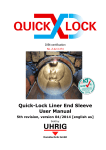
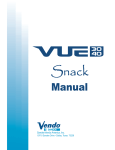


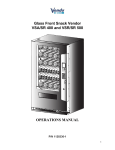
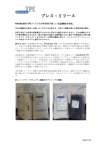
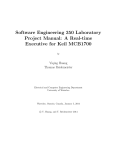




![[Manual Makeup] - inverter & Plc](http://vs1.manualzilla.com/store/data/005906079_1-ccf407c70ed6dc9ae9bfcbd31676317c-150x150.png)
